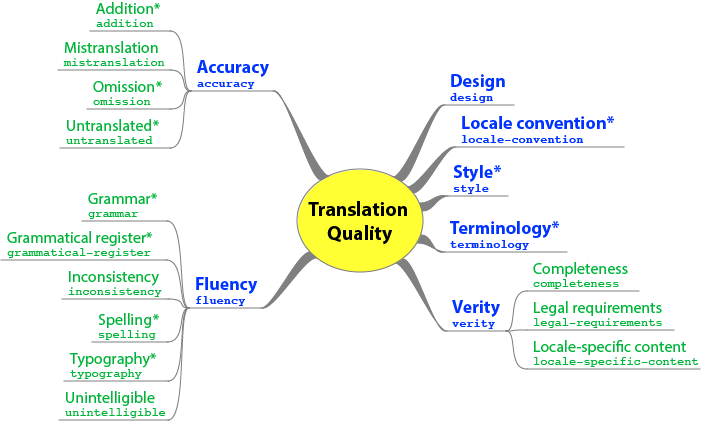Plenty of models are being adopted by companies to assess their translations. Some translation service providers also design their own models based on the available results of previous ones. Translation models all base their assessment on assessment categories for language products, e.g. Language, Grammar and terminology. Let’s find out about the two most common QA model recently.
What is the a QA Model?
Generally, quality assurance is carried out based on two models: error rating and rubrics for assessment. The former is more common and the quality assessment will rely on error counting and rating of each error. The number of points reflects the quality of a translation; points are given to errors made according to the number of errors and the “severity” of errors, with final result in the form of a percentage. As such, an error rating model can be understood to be based on the following two factors for assessment:
- Severity: the seriousness level of an error, based on the assessment of a proofreader on how the error will affect readers.
- Weight: a multiplier corresponds to the severity of an error.
The less common model is criteria-based assessment. The initial point is 0 and will be added according to the fulfillment of criteria or achievable factors of a translation. However, unlike in academic fields, this model has not seen much adoption in the translation industry.
The LISA QA Model
Lisa QA Model v3.1 was introduced in the 1990s in the form of an error rating model, boasting full features of such a standard model. LISA QA rates an error according to its severity, along with the corresponding weight, that is, minor, major and critical with the points of 1, 5 and 10 respectively for each type of error. The model records linguistic and other technical errors (text interface, typeface, etc.), bringing the number of error categories to 7 if user interface is to be considered.

According to LISA, the PASS and FAIL points are proportional to the number of words in a translation. A 300-word translation with 3 minor errors (3 points) will still be rated as FAIL, because the maximum score allowed is 2 points. 3 errors in a 2000-word translation will not matter because the score allowed can be up to 9 (points). However, a single critical error will cause a translation to immediately fail, because the weight of a critical error is 10 points.
Benefits of the LISA QA Model
The LISA QA Model is a database-based application, providing a framework for measurement of translation and localization quality. Adoption of the LISA QA Model helps to ensure the consistency of terminology and content, as well as encourages translators not to make avoidable errors that will result in point reduction, causing the output to fail to meet the requirements.
MQM Model
There is a new and much welcome model called MQM – Multidimensional Quality Metrics. MQM is a flexible system providing translation assessment metrics. Although MQM focuses on the quality aspect of a translation, it can also be used to assess a text in source language, thereby analyzing issues in the source text and how they will affect the quality of the translation.

MQM was also designed for random translated texts, but is not an all-purpose model for translation quality assessment. The process for translation quality assessment of MQM includes four steps, each specifying its own options or parameters . However, there are two major disadvantages to MQM, the first being that hidden and static factors in MQM 1.0 and others quality analysis standards should all be able to be seen and changed in MQM 2.0. The second being that MQM is divided according to periods, functions and parameters; available products should be able to be recycled for a random period or parameters should be able to be changed to produce new data, thereby customizing standard measures.
On the other hand, the strengths of MQM lie in its ability to strike a balance between storage of past efforts and maintenance of future figure options. MQM is an ideal model to be used as an analysis tool. Moreover, MQM can easily be adapted to serve as a basis for overall assessment.
Summary
As a modern trend, all CAT tools, either online or offline, tend to integrate with a QA model or at least QA functions. This helps to deliver a project at a full scale with compliance to standard translation process according to ISO 17100:2015. Therefore, besides translation skills, translators should obtain a common understanding of the QA technology to boost their QA tasks.






